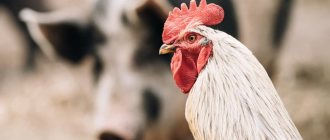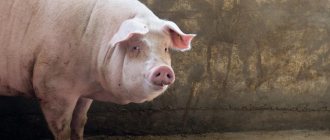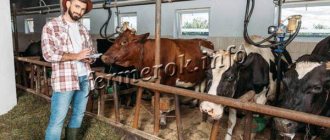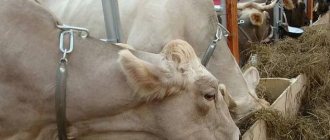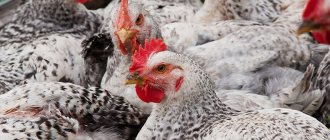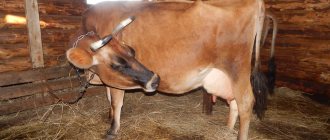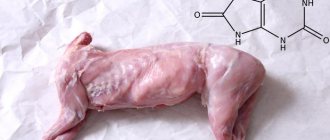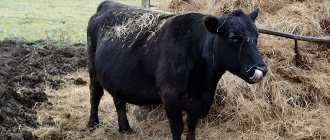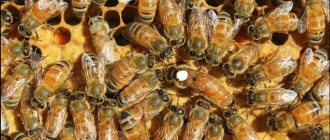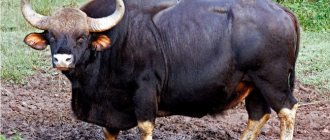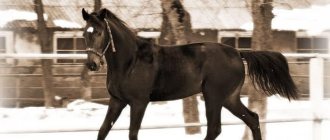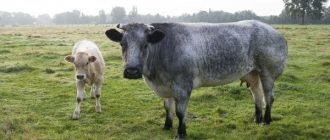History and genetics
The first stage of selection was the crossing of local motley cattle with the Simmental breed to obtain a working-meat type of individuals with a strong constitution, well adapted to grazing. In the 19th century, an infusion of blood from Shorthorn breeders was carried out, the purpose of which was the precocity of individuals and an increase in the proportion of muscle tissue in the carcass. The Charolais breed was established as an independent breed in the middle of the 19th century, and since then the reproduction of the population has been realized only through purebred crossing. Breeding Charolais cows is regulated in France at the state level - special breeding farms and federations of farmers have been created. High-quality Charolais genetic material is used by breeders around the world to improve the performance of less productive breeds.
Charolais cow breed
When and where was it released?
The homeland of this early ripening breed, which has earned good reviews from farmers, is France. For the first time, such animals began to be bred in this country in the province of Charolais. This is where the name of the breed comes from.
One of the traditions of French cooking is the use of mainly lean beef for preparing various types of dishes. Accordingly, the selection of beef cattle in this country is mainly aimed at increasing the muscle mass of livestock with a small amount of fat.
This is how the popular breed of Charolais cows was bred in France. The keeping of such cows in this country began back in the 19th century. Subsequently, the Charolais breed spread widely throughout the world. Today, such cows are raised in almost all countries on the planet where beef cattle breeding is well developed.
In Russia, traditionally only dairy cattle are kept. In our country, Charolais cattle are not very widespread. Large farmers do not breed such cows. But they are maintained by many private owners.
Geography of distribution
Due to the fact that the formation of the breed took place in the mild and humid climate of France, Charolais meat is characterized by a low fat content - it is a lean product with high taste characteristics, in addition, individuals quickly reach slaughter age. Being at the same time hardy and flexible, representatives of the breed quickly gained popularity throughout the continent as a highly profitable species. Today, Charolais is bred and used for selection in more than seventy countries around the world, in particular in Russia, in the Tyumen, Belgorod, Tver and Kaluga regions, and in the Krasnodar Territory.
"Auliekol" breed of beef cows
The Auliekol breed is characterized by high early maturity and growth vigor. Ideally adapted to our climatic conditions. The live weight of an adult bull ranges from 950 kilograms to 1.1 tons. A case was recorded when an adult bull reached a weight of one and a half tons. The average weight of a cow is about 540-560 kilograms. The percentage of slaughter yield is within 60-63 percent.
Breed characteristics
Charolais cows are much smaller than bulls - the weight of an adult cow ranges from 650 to 1100 kg, and a bull is on average 400 - 500 kg more, so the weight of a bull often reaches 1500 kg. The breed is large-fruited, the probability of calving twins is quite high (about 4%). The weight of a newborn calf exceeds 50 kg, the daily weight gain reaches 1.5 kg, and at one and a half years the individual weighs on average 350-450 kg. Intensive growth continues for up to two years. Charolais color is predominantly light, fawn or cream with a yellow tint, without spots. The coat is thin and of medium length. Both bulls and cows are distinguished by a strong, proportional physique, well-developed muscles with equal growth in the front and back of the body, correct placement of the limbs, a small head and a short, massive neck. The back of a purebred Charolais should be straight and broad. The height at the withers of an adult reaches one and a half meters in cows and 170 cm in bulls, the oblique body length is 220 cm in individuals of either sex. The horns are of medium length and rounded; in cows, as a rule, they are shorter. The nasal planum is smooth and light pink in color. The udder of cows is small and cup-shaped.
Cattle keeping and animal care
An adult cow and bull of the Charolais breed is distinguished by its endurance. However, in cold areas it is difficult to keep them due to a thin layer of fat. Animals cannot heat themselves. Sudden temperature changes are dangerous for them. The care and maintenance of animals occurs according to the following rules:
- Bulls have a large build. They need a spacious stall, heated in winter. Separate compartments are provided for pregnant cows and calves. Animals are provided with peace and comfort.
- In the warm season, a pasture management method is required. The more animals eat fresh grass, the less they get sick and their productivity increases. Stall housing is practiced in winter with the obligatory presence of hay and concentrated feed in the diet.
- The body of bulls and females requires salt. A salt stone must be placed in each stall for licking.
- There should always be fresh water in the pasture and in the stall. If the drinking bowl is empty during the heat, the animal becomes aggressive from thirst.
- A veterinarian constantly monitors the health of the cattle. External examinations of the hooves, skin, eyes and teeth are important. The veterinarian monitors muscle development. Vaccinations are required, which are most needed for calves and females.
- The stall is cleaned as it gets dirty, but at least once a day. The litter is kept dry. Dampness inside the barn is unacceptable.
See also: How much does a 1 year old bull weigh live?
In winter, heating is carried out by heating. Ventilation regulates air exchange and humidity.
Important! Charolais cannot be crossed with representatives of other breeds. The offspring are not purebred, often with poor characteristics.
Productivity
As already mentioned, Charolais is a meat breed of cattle. The age of animals suitable for slaughter begins at 1.5 years and lasts 15 years, while no signs of aging are observed in the meat. The slaughter yield is 60-70% from the carcass, the yield of high quality meat is 80%. The breed's milk production also has quite high indicators - from one and a half to two tons of milk with a fat content of 4% per year. Housing conditions: Charolais cattle are hardy and acclimatize well, but are sensitive to low temperatures - cases of frostbite of the udder and limbs are common. To gain muscle mass, the breed needs grazing, and during periods when access to pasture is limited, animals actively consume concentrated feed.
How much does a calf cost?
Such cattle have earned good reviews from domestic homestead owners. But Charolais in Russia, as already mentioned, is not a very common breed. Private owners have the opportunity to buy such a calf. But young Charolais in our country, unfortunately, is quite expensive. The price for a calf is in most cases at least 30 thousand rubles. The cost of breeding bulls of this breed can reach up to 90-100 thousand rubles.
In addition, since there are no Charolais breeding farms in Russia, the owner of a farmstead always runs the risk of acquiring a half-breed. Perhaps such a bull will subsequently gain a lot of weight. But still, it will no longer be Charolais.
Summarize
The obvious advantages of the Charolais breed as meat are the taste characteristics and the low percentage of fat content in Charolais beef, which is practically unrivaled in the market. Cattle are early maturing, the period of their productive use is long, and the age of the cow does not affect the quality of meat and milk. Breeding the breed is strictly regulated, so finding purebred sires will not be a problem, as will further reproduction - the good heredity of the Charolais is confirmed by the two-hundred-year history of the breed. Disadvantages are limited to problematic calving (due to the tendency of a large fetus) - cesarean section is used quite often, and the sensitivity of the breed to temperature changes.
Diet
In summer, the livestock is kept on pasture. The herd is taken to the pens at sunset. The pens are made open, with a canopy. Bedding is laid on the ground. In addition to meadow grass, in summer the animals are fed hay at the rate of 1 kg per 1 kg of animal weight. During milking, cows are given concentrates and a grain mixture: 500 g per 1 centner of weight.
Read more: Hazelnut nut where to buy large-sized seedlings of the Moscow sugar trapezund variety with description
For bulls, combined feed is distributed into feeders. The mixture is given together with hay or separately. Pasture is chosen near a watering place. If it is an erik or a lake, then the water must be analyzed for pathogens of infectious diseases.
In winter, the herd is housed in a barn. Despite the fact that the animals have long hair, they cannot tolerate frost. You can walk them in the pen. If the temperature is not lower than 20 degrees. The duration of the walk is no more than 2 hours. During this time, the operators will have time to clean the stalls and lay down fresh bedding.
The temperature in the barn should not be lower than 15 C. The room is ventilated. If necessary, install forced ventilation in it. With a high content of ammonia and carbon dioxide in the air, animals begin to get sick. They develop upper respiratory tract diseases.
Winter feeding differs from summer feeding. The bulls are put into fattening. For them, the silage method is used.
https://www.youtube.com/watch?v=subscribe_widget
For bulls, the following feeding scheme is described:
- 1 month – silage 30 kg, straw 3 kg, concentrates 1.5 kg, salt 30 g;
- 2 month – silage 25 kg, straw 2 kg, hay 1 kg, concentrates 1.6 kg, salt 35 g;
- 3 month – silage 20 kg, straw 1 kg, hay 2 kg, concentrates 1.9 kg, salt 35 g.
More on the topic:
Features of the structure of the milking machine for cows
| № | Helpful information |
| 1 | 3 kg of hay and straw |
| 2 | 11 kg haylage |
| 3 | 10 kg corn silage |
| 4 | 1.5 kg concentrates |
| 5 | 300 g molasses |
| 6 | 50 g premix |
The diet is designed for a cow weighing 600 kg. It is used in the first half of the lactation period. Next, the diet is adjusted. If milk yield is stable, the feeding scheme is left. When productivity decreases, the amount of feed is reduced.
Animals of the Charolais breed have good characteristics. In addition to high meat and dairy productivity, their unpretentiousness in food is noted. Of course, they should not be given rotten, spoiled or dirty food, but it is quite possible to change the types of food. Instead of part of the silage, they sometimes give vegetables, instead of combined feed, a grain mixture. Animals will eat everything. Changing feed will not affect productivity.
Heading Cattle farm Charolais bulls Viewing time 2:50 Heading Charolais cows. Went AWOL.Watching time1:07Title Charolais breed.Watching time1:11
The unpretentiousness of Charolais cows also extends to their eating habits. For good weight gain, regular feeding with oats or straw is enough for them - cows agree to any food and easily digest it. In summer, spending on food can be completely limited - high-quality grass will be enough for cows to eat and gain good body weight.
The choice of feed does not affect weight gain; weight is steadily gained during the first two years of the calves’ life. When raising a bull for slaughter, it is enough to fatten it for 2-3 months, but adult animals will also be useful on the farm.
Charolais cows are unpretentious eaters
Brief descriptions of the most interesting breeds
Beef has always been more expensive than other types of meat and for a long time remained a product available only to wealthy buyers. To some extent, this situation continues today, but the success of breeders in breeding more “early maturing” breeds of cows is gradually changing the situation for the better. Let's look at the characteristics of some of them:
"Aberdeen Angus"
Developed in Scotland in the 1930s. Coat color is black or reddish brown. Animals of medium height, dense build, genetically polled. The weight of an adult male reaches a ton. Females can mate from the age of 15-16 months, the young quickly gain weight and produce “marbled” beef of excellent quality.
Burenki easily adapt to harsh climates and have excellent health
"Belgian Blue" ("Blank-Blue Belge")
The ancestors of these cows have been known in Belgium since the 18th century. They were heavily crossed with Shorthorns and Charolaises. In 1960, a mutated gene (the so-called “double muscle gene”) was identified in some representatives of the resulting hybrid varieties, the presence of which allowed animal organisms to continuously increase muscle mass. As a result of further selection, a breed was obtained that is characterized by a very distinctive appearance and exceptional meat productivity. The animals have thin skin that is whitish, light blue, black or red. Adult males reach a weight of 1250 kg; the meat yield from the carcass is 70-80%. The product is considered dietary: it is very tender and juicy. Females show a milk yield that is rare for “meat” cattle – from 2500 to 4500 kg of milk per lactation with a fat content of 3.5-4.1%.
“Belgians” have a calm disposition and are not too fussy about food. However, the breed is not without its drawbacks: females reach sexual maturity late (the first calving is possible at the age of 28-35 months). In addition, they have too narrow a pelvis and, as a rule, cannot do without veterinary care when calving.
Due to the very short hair and almost complete absence of subcutaneous fat, the muscles look like “pumped up”
"Hereford"
One of the most numerous and widespread cattle breeds in the world. Brought out in England in the middle of the 18th century. In this case, selection was carried out not so much in the direction of increasing productivity, but with the goal of obtaining the most unpretentious cows, capable of adapting to any conditions of keeping and feeding. The coat color is red (less often – black), the head, withers and lower body are white. Bulls reach a weight of 1000 kg. Females bear offspring annually and calve without human assistance. Calves grow quickly: the average daily weight gain is about 1200-1500 g. The slaughter yield from the carcass is 60-70%. The quality of the meat is characterized as very high: it is from Herefords that the best “marbled” beef, very nutritious and tasty, is obtained.
"Herefords" are especially valued for their ability not only to live, but also to build muscle mass in any climate with limited and monotonous diets
"Kazakh white-headed"
Brought out on the territory of modern Kazakhstan, as well as the Volgograd and Orenburg regions in the first half of the 20th century (the standard was formed by 1950). Breeders used local cows, which were crossed with Kalmyk bulls and Herefords. The color of the skin is red or reddish-brown; the lower part of the body, chest, head and tail tuft are white. The weight of adult bulls is 850-1000 kg. By the age of one and a half years, young animals “fat up” up to 470 kg. Burenki are unpretentious and easily adapt to harsh climates.
In winter, animals grow thick, long, sometimes curly hair.
"Kalmytskaya"
Obtained by directed selection based on material from cows that have lived since ancient times on the territory of modern Mongolia. The color is red (sometimes with white spots). The body weight of an adult bull is about 900 kg. Castrated bull calves, which reach a weight of 520-530 kg by the age of 18 months with intensive fattening, produce meat that has exceptional taste. In our country, the breed is widely used to increase the meat productivity of other varieties of cattle.
Cattle are unpretentious; when kept in regions with a mild climate, they are able to feed on pasture all year round.
"Limousin"
Brought out at the end of the 19th century in France. Coat color is red (from light fawn to dark red). The weight of an adult male reaches more than 1100 kg. “Limousines” are distinguished by very impressive indicators of the quality of meat products: the yield from a bull carcass is 64%, but there is about 6.5 kg of pulp per kilogram of bones.
“Limousines” are hardy, unpretentious, perfectly adapted to grazing
"Salers"
French breeders developed the breed using cattle material, which since ancient times was raised on high mountain pastures and used by local peasants as draft power. The color is dark red. The coat is thick and curly. The body weight of adult bulls reaches 1500 kg. Burenki are famous for easy calving and long-term productivity. Young calves are fattened for meat, but adult cows are also used as milk cows. Each produces no more than 2000 kg of milk per lactation, but it has unique taste properties and today, like several centuries ago, is used to make delicious varieties of cheese - Cantal, Sennecter and Salers.
Animals are unpretentious, resistant to adverse climatic conditions
"Santa Gertrude"
The variety was obtained in the USA (in the state of Texas) as a result of crossing “shorthorns” with Indian zebu and is actually an interspecific hybrid. Coat color is red. The animals are hardy, can easily tolerate heat, and are undemanding when it comes to food: they can get by on pasture that is not of the highest quality (reeds, plants of arid steppes, etc.). Genetically resistant to diseases carried by blood-sucking insects (for example, piroplasmosis). The daily weight gain of calves reaches 1000-1200 g. Adult bulls weigh about 900-1000 kg.
The hybrid is valued for its unpretentiousness and good adaptability to difficult conditions.
"Charollesian"
A variety of cattle native to France. Color – light (from white to light yellow). The live weight of an adult male reaches 1200 kg, females gain an average of 650-1000 kg. Young animals have a very high growth rate: the average daily weight gain is 1000-1800 g.
The disadvantage of the breed is considered to be the large weight of the calf at the time of birth, which often becomes the cause of difficult calvings.
Milk productivity is 1800-2700 kg per lactation with milk fat content at 4.0%
"Shorthorn"
The breed has been known for more than two centuries. Obtained as a result of crossing several British, Scottish and Dutch varieties of cattle. The color is red, with blurry white spots. The coat is thick and quite long. An adult bull can weigh up to a ton. Meat products are of excellent quality.
Unfortunately, Shorthorns demonstrate some “capriciousness” in food and excessive sensitivity to unfavorable climatic conditions, which limits their distribution in our country.
The animals are famous for their trouble-free calving, early maturity, and easy-going disposition.
